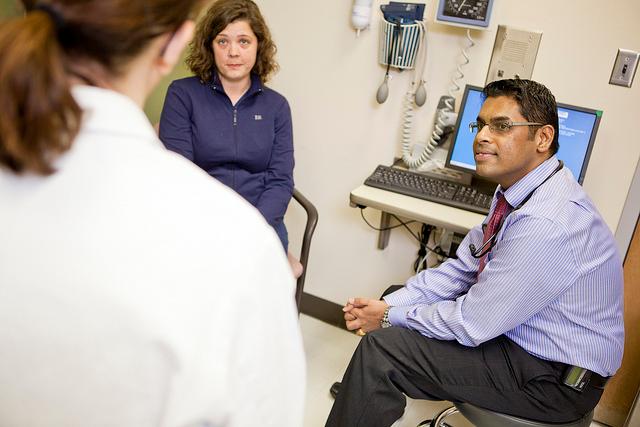The doctor will see (all of) you now
Doctors and residents working with patients at the JFK clinic in St. Louis on February 28, 2012. (Photo courtesy of Mercy Health)
We’ve all been to the doctor, and we all know how it goes.
Check in with the receptionist, sit in the waiting room, and then after some time, meet one-on-one with the doctor for a few minutes. But imagine that the scenario is slightly different.
You still check in and sit in the waiting room. But rather than meet one-on-one with the doctor when your name is called, you meet with the doctor and several other patients. You and the other patients talk about your symptoms together. You get advice from the doctor together.
Yes, you even get examined together.
This might sound like a nightmare for those used to traditional doctors visits, but more and more doctors are seeing their patients in groups these days. Today, 13 percent of medical practices have the option of group doctor visits.
According to Dr. Alexander Kuo, professor of medicine and director of hepatology at University of California-San Diego, the group approach is not a one-size-fits-all solution for all patients, but can be effective in certain situations, gathering those with similar diagnoses for example
“When they’re there in the group, not only are they learning from the doctors one-on-one interaction with them, but they’re learning by listening to the questions that other patients in the group might have, they might have thought of questions you might have not thought of yourself,” Kuo said.
Group sessions allow patients and doctors to meet for far longer than they’re able to during one-on-one visits. With multiple patients in one room, doctors are able to work for much longer. Kuo estimates he’s able to dedicate 90 minutes to patients he previously would only be able to give 20.
Group sessions would be a good fit for the majority of Kuo’s patients he said. However, he said “wallflowers” and those who tend to overpower conversations could be ill suited for such an interaction.
“But those are really the extremes,” he said. “For the most part, I’d say 80 to 90 percent of patients in my practice would be really appropriate for this kind of group visit.”
Because a doctor’s visit is inherently a personal interaction, Kuo takes precautions to maintain boundaries between patients in the group sessions, including a privacy room for check-ups that involve disrobing.
Still, some have criticized group sessions for what they consider a lack of privacy.
“The problem in a group setting is that those same rules that govern how health information is stored and transmitted and maintained, they do not apply to individuals they apply to healthcare providers,” said Rabeh M.A. Soofi.
To combat privacy problems, Kuo allows patients to bring a guest to the session and requires all in attendance to sign a confidentiality agreement.
For some, like many in Kuo’s group of liver disease patients, the sessions are less about efficiency than a sense of community and real understanding they can’t get anywhere else.
“When you’re diagnosed with advanced liver disease it can really feel isolating,” Kuo said. “It’s scary to be told that you have cirrhosis and you need a liver transplant and by bringing patients with similar problems together they really feel empowered.”
Every day, reporters and producers at The World are hard at work bringing you human-centered news from across the globe. But we can’t do it without you. We need your support to ensure we can continue this work for another year.
Make a gift today, and you’ll help us unlock a matching gift of $67,000!
